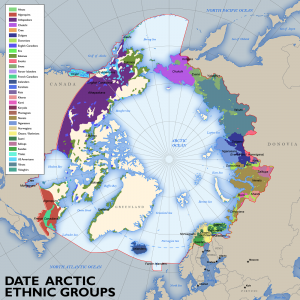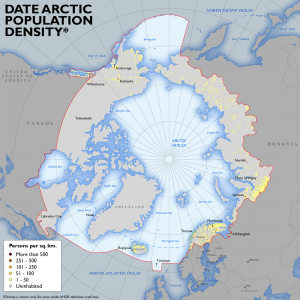Difference between revisions of "Social: Arctic"
Pino.Tony1 (talk | contribs) (major update) (Tag: Visual edit) |
Pino.Tony1 (talk | contribs) m (→Ethnicities: added graphics) (Tag: Visual edit) |
||
| Line 11: | Line 11: | ||
== Languages == | == Languages == | ||
| + | [[File:DATE Arctic Ethnic Groups.png|thumb|Ethnicities of the Arctic]] | ||
== Ethnicities == | == Ethnicities == | ||
| Line 28: | Line 29: | ||
The vast majority of the Arctic population is located in the European Arctic. The global population above the Arctic Circle includes approximately four million people, half of which reside in Donovia. Donovia has the largest Arctic population ? over half of the total Arctic population ? but Norway has the largest percentage (10 percent) of its population living north of the Arctic Circle. Arctic communities are predominately coastal and generally characterized by densely populated areas separated by long distances. | The vast majority of the Arctic population is located in the European Arctic. The global population above the Arctic Circle includes approximately four million people, half of which reside in Donovia. Donovia has the largest Arctic population ? over half of the total Arctic population ? but Norway has the largest percentage (10 percent) of its population living north of the Arctic Circle. Arctic communities are predominately coastal and generally characterized by densely populated areas separated by long distances. | ||
| + | [[File:DATE Arctic Population Density.png|thumb|Population density in the Arctic region. ]] | ||
== Population Density == | == Population Density == | ||
Latest revision as of 19:28, 8 February 2022
Contents
Overview
Because of environmental extremes, the Arctic population is small, dispersed, and isolated compared to the populations of other geographic regions. Populations cluster in comparatively milder European Arctic areas and around economic resources, which have historically been associated with subsistence but increasingly involve mineral and energy reserves.
While many populations are either transient or temporary, the indigenous peoples living above the Arctic Circle continue to endure the Arctic extremes. The majority of Arctic indigenous peoples live in the European portion of the Arctic, with Donovia having the largest population.
Languages
Ethnicities
Indigenous populations represent a sizeable portion of the population in the Western Hemisphere and a minority of the population in the Eastern hemisphere, including 80% of the population in Greenland, 50% in Canada, 20% in Alaska, 15% in Arctic Norway, and 3-4% in Arctic Donovia.
The largest cross---linguistic groups in the territories of each respective Arctic nation.
Traditionally, Arctic native peoples lived primarily from hunting, fishing, herding, and gathering wild plants for food, although farming is also practiced. Northern people found many different ways to adapt to the Arctic climate, including weather prediction and navigation in icy seas.
In the wake of urbanization and modernization, there is an active movement among indigenous people in the Arctic to pass on traditional knowledge and skills, such as hunting, fishing, herding, and native languages, to the younger generation. Certain industries associate with these practices, such as reindeer husbandry, are protected practices within their respective nations.
Religions
Various denominations of Christianity are predominant across all Arctic areas. Since the mid-20th century, there has been some resurgence of interest in traditional religion among indigenous groups. Each is unique, but there are similarities across the different Arctic indigenous groups. All groups view their environments as spiritual, and the acts of gift-giving and reciprocity are extremely important.
Education
Indigenous and nonindigenous Arctic communities in Donovia and the Western Hemisphere have lower average education rate and higher levels of social and health problems than southern and Western European Arctic communities.
The vast majority of the Arctic population is located in the European Arctic. The global population above the Arctic Circle includes approximately four million people, half of which reside in Donovia. Donovia has the largest Arctic population ? over half of the total Arctic population ? but Norway has the largest percentage (10 percent) of its population living north of the Arctic Circle. Arctic communities are predominately coastal and generally characterized by densely populated areas separated by long distances.
Population Density
The vast majority of the Arctic population is located in the European Arctic. The global population above the Arctic Circle includes approximately four million people, half of which reside in Donovia. Donovia has the largest Arctic population ? over half of the total Arctic population ? but Norway has the largest percentage (10 percent) of its population living north of the Arctic Circle. Arctic communities are predominately coastal and generally characterized by densely populated areas separated by long distances.
Urban Areas
Rural Areas
Asian and North American Arctic regions, conversely, are characterized by small, isolated communities separated by vast swaths of uninhabited or sparsely-
Population Movement
Internal Migration
Populations are slowly urbanizing in all Arctic areas through a combination of social, environmental, and economic reasons. Climate change and the resultant economic development are threatening the economies and lifestyles of indigenous circumpolar peoples in all Arctic countries, which have traditionally revolved around subsistence hunting and fishing.
External Migration
Following an era of decline in the late 20th century, the overall Arctic population has stabilized, with general decreases in Donovia and increases in Western Hemispheric countries, attributed to natural resource exploitation. Inbound persons are predominantly associated with growing industries in natural resource exploitation


